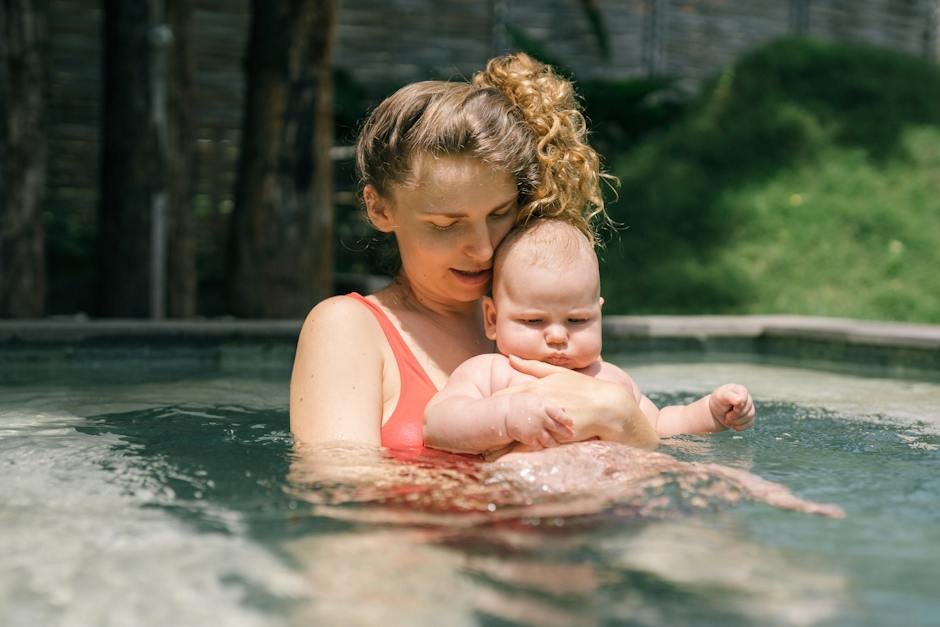
Swimming, an activity that presents an array of sensory experiences, can prove to be a challenging task for individuals with sensory processing disorders or sensitivities. The feel of water, its temperature and pressure, alongside the sounds associated with it can often be overwhelming. However, the ability to swim not only provides an essential life skill, but can also serve as a therapeutic outlet when properly modified and adapted. This exploration delves into understanding sensory issues, developing strategies for adapting swimming lessons, as well as toward discovering supportive resources and tools to create a less daunting and more beneficial learning experience.
Understanding Sensory Issues
Navigating Sensory Issues During Swimming Lessons: A Parent’s Guide
Here’s a little-known fact: the term “sensory issues” refers to a condition where the person struggles to process or respond to certain sensory information from their environment. If you’re a parent, you might have a child dealing with this situation, and it could hinder their experience during swimming lessons or other recreational activities. Standing strong for our kids is the essence of parenthood, whether that means helping them climb the jungle gym or teaching them how to stay afloat in the deep end, so let’s delve deeper into this topic.
Sensory issues arise from a condition known as Sensory Processing Disorder (SPD). Traditionally, these issues are associated with Autism Spectrum Disorder (ASD), but they can also occur independently. Children who experience sensory issues might exhibit hypersensitivity or hypersensitivity to sensory stimuli. This could be evident in their reactions to noises, textures, tastes, light, or, in the case of swimming lessons, water.
Swimming can encompass a torrent of sensory experiences for a child. The feel of water slapping against the skin, the echoing shouts and splashes, the coolness or warmth of the water, or even the taste and smell of chlorine can be overwhelming for a child with sensory issues. This overload can result in acute fear or anxiety, ultimately interfering with their ability to learn and enjoy swimming.
So, how do you navigate this tricky terrain?
First, it’s essential to communicate with the swimming instructor before the lessons begin. Provide them with a clear understanding of your child’s sensory challenges, and what might trigger a sensory overload. A seasoned instructor will be able to customize the lessons, encouraging gradual adaptation to the water environment.
Consider investing in a few sensory-friendly swimming aids. For example, smooth-surfaced pool toys can help in cases of touch-related sensitivity, and earplugs can help dampen noise for children sensitive to auditory inputs – a swimming cap might also help limit the water’s impact on the child’s head and face.
Practice is another key component. Try and create a familiar environment at home, like a bathtub or even a small inflatable pool. Both can be a wonderful starting point for children to get used to the sensation of being in water.
Remember, patience is key here. Allow your child to gradually acclimatize to the experience, and always reassure them that it’s okay to take their time. Mastery of confidence in the water is like planting a seed – with care, patience, and time, it will grow.
Pesky as sensory issues may be, know that they are by no means a definitive barrier. Countless children with sensory issues have successfully learned to swim, and the therapeutic benefits of being in the water can be an enriching experience for them. With our guidance, understanding, and support, we can help write their story of triumph over sensory challenges in the undeniable language of parental love.

Adapting Swimming Lessons
Adapting Swimming Lessons for Sensory Challenges: More in-depth Considerations
Swimming lessons can be an especially challenging endeavor for individuals struggling with sensory issues. However, the stress and fear faced by these individuals need not be a stumbling block. By deploying certain adaptive strategies, swimming instructors, parents, and guardians can make a world of difference in the learning experience, and ultimately, the swimming success of individuals with sensory processing disorders. Here’s how.
Adopting a Personalized Approach
Every individual’s sensory experiences are unique – what works for one person may not work for another. Hence, it’s absolutely essential to create a personalized lesson plan that takes into consideration the individual’s specific sensory needs. Get insights about their preferences and triggers. This might involve keeping the water at a certain temperature, choosing a quieter time for the lessons, or using buoyancy aids or floatation devices they are comfortable with. Sometimes, reducing the duration of swimming lessons can also help in managing sensory overload.
Implementing Desensitization Techniques
Acclimatizing the individual to the swimming environment gradually can be very beneficial. Start by exposing them to the sensory aspects of swimming in small, manageable doses and then slowly increase this exposure. This could be as simple as splashing water on their skin, playing with water toys, or blowing bubbles in the water before getting into the pool.
Utilizing Visual Aids
Visual aids like illustrated step-by-step guides can be invaluable to individuals with sensory issues. They provide a clear understanding of what to expect, thereby reducing any unforeseen sensory triggers throughout the swimming lesson.
Encouraging Use of Sensory Interventions
Devices such as weighted vests or sensory brushes not only provide comfort but can also help manage sensory stimulation. Earplugs or special swim caps might also come in handy if the individual finds the sound or sensation of water overwhelming.
The Physical Environment Matters
Lastly, while the pool’s physical conditions—like the level of chlorine, the pool’s lighting, the noise level—are usually standard, they can be distressing for individuals with sensory issues. In such instances, look for alternatives like saltwater pools, outdoor pools with natural light, or pools that allow for calmer, quieter swim slots.
Remember, adapting swimming lessons to accommodate sensory issues is not a one-size-fits-all approach. It’s a journey that involves experimentation, patience, and plenty of reassurance. And through it all, the key is to stay flexible and keep the channels of communication open with the individual and their caregiver. With these strategies in place, swimming lessons can become an enjoyable and therapeutic activity, contributing significantly towards improving the well-being of individuals grappling with sensory issues.

Supportive Resources and Tools
Tools and Resources to Facilitate Swimming Lessons for Children With Sensory Issues
In our ongoing journey to equipped parents with effective strategies for managing sensory concerns during swimming lessons, let’s delve further by exploring the necessary tools and resources. Here’s our curated collection of resources precisely designed to ensure you have all you need to empower your child through their sensory challenges in swimming.
One crucial tool to have in your arsenal is a weight vest. Children with Sensory Processing Disorder often seek out deep pressure, which a weight vest can provide. This tool can give your child a sense of calm and help them focus on the task at hand – swimming!
Next, silicon earplugs and nose clips often become useful tools for children dealing with sensory issues. As sensory issues make them hypersensitive to water entering their ears or nose, these accessories provide an added layer of protection and increase comfort, enabling them to concentrate better on the lessons.
Using sensory toys can also aid in the process. Aquatic sensory toys – like diving sticks, torpedos, or colorful sinkable gems – can make the unfamiliar environment more enticing and less daunting for children. These toys help by providing a fun touch to the lessons which will both distract and engage your little ones.
Also, it’s essential to look into specific swimwear for children with sensory issues. Seamless, tagless, or snug-fitting swimsuits may alleviate tactile sensitives, making swimming lessons more enjoyable and less stressful for your child.
On the resource side, countless books and online platforms can offer you a wealth of information on this topic. For instance, “The Out-of-Sync Child” by Carol Kranowitz provides excellent insights into sensory challenges. Websites like Understood.org or the STAR Institute for SPD are abundant with resources, tips, and guidance on sensory issues, including overcoming sensory challenges in swimming.
Workshops and seminars also prove to be vital resources. Seek out local or online workshops that cater specifically to the subject of sensory issues and swimming.
Technology-based tools, like apps, can also help. For instance, “Birdhouse for Autism” is an excellent app that allows you to track your child’s sensory triggers, which can be particularly helpful during swimming lessons.
Don’t forget to consider sensory-friendly swimming schools. More establishments are now offering specialized swimming lessons catering to children with sensory issues. These schools take special efforts to create a physical environment conducive to learning – for example, the use of muted lighting or quieter surroundings can significantly help kids with sensory issues.
Lastly, incorporate resources like Occupational Therapists who specialize in sensory processing. They can give practical advice, techniques, and at-home exercises to assist in your child’s journey of sensory integration in a swimming scenario.
Remember, every child is unique, and what works for one might not work for another. Definitely explore these resources and tools, but always tailor them to your child’s particular sensitivities and preferences in order to create the most successful swimming experience possible. Your love, understanding, and tireless pursuit of the right resources can make a world of difference for your child!

With the proper understanding of the nature of sensory issues, thoughtful modifications to swimming lessons, and the use of supportive resources and tools, one can ensure swimming becomes a positive and constructive experience for individuals grappling with sensory issues. The path may entail trying different methods or resources before finding the perfect fit, but the empowerment and freedom granted by the ability to swim is certainly worth the journey. Let’s remember to be patient, adaptable, and supportive to all individuals, affirming that swimming is indeed an inclusive sport that everyone should enjoy and benefit from.




